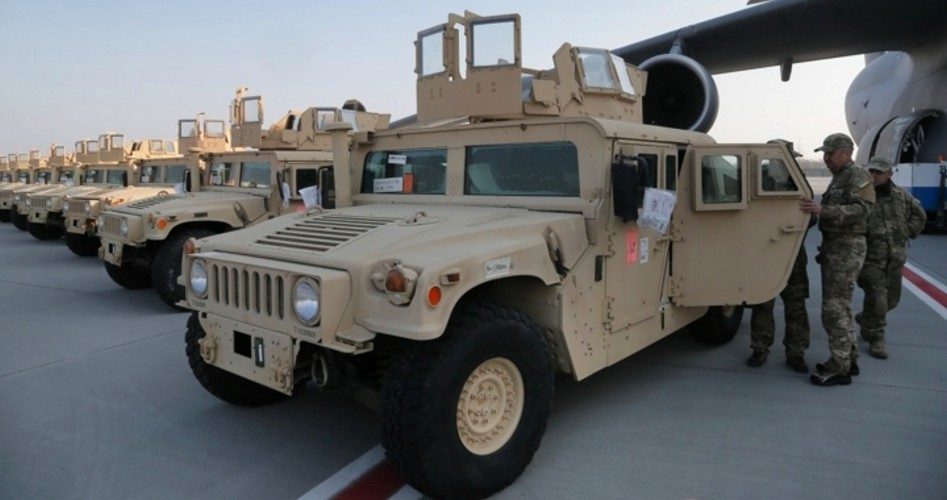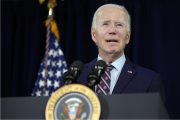
The first 10 of 30 Humvee armored vehicles that the United States has agreed to supply to Ukraine arrived in the country’s capital of Kiev on March 25. Ukraine President Petro Poroshenko personally took possession of the vehicles at Kiev’s Boryspil International Airport.
AFP reported that the United States plans to send Ukraine 200 Humvees, radios, counter-mortar radars, and other non-lethal equipment worth $75 million. The report did not state whether Ukraine is paying for this equipment or it is considered to be foreign aid.
Earlier this week, the House of Representatives voted 348-48 to approve House Resolution 162, “Calling on the President to provide Ukraine with military assistance to defend its sovereignty and territorial integrity.”
The government of Ukraine has been engaged in conflict with pro-Russian separatists since early last year. Ukraine’s Parliament removed former President Viktor Yanukovych from power on February 22, 2014, and two days later issued a warrant for his arrest, accusing him of “mass killing of civilians” during violent anti-government protests. Yanukovych fled to Russia, where he declared himself to still be “the legitimate head of the Ukrainian state elected in a free vote by Ukrainian citizens.”
Yanukovych’s fall from power had begun in 2013, when, under pressure from Russian President Vladimir Putin, he rejected a pending EU association agreement, choosing instead to pursue a Russian loan bailout and closer ties with Russia. This led to the mass “Euromaidan” protests and the occupation of Kiev’s Independence Square by young pro-European Union Ukrainians. The protests spread across the Ukraine as Ukrainian citizens confronted the Berkut and other special police units, and by February 2014, just before Yanukovych’s ouster, Ukraine appeared to be on the brink of civil war.
Poroshenko actively supported the “Euromaidan” protests, which contributed to his popularity, and he was elected president in May 2014. Following his election Poroshenko announced, “My first presidential trip will be to Donbas.” Donbas, in eastern Ukraine, had become a scene of unrest in March 2014, following the political revolution that had unseated Yanukovych. This unrest later grew into a war between pro-Russian separatists affiliated with the breakaway Donetsk and Luhansk People’s Republics, and the post-revolutionary Ukrainian government.
About the same time that the unrest in Ukraine had started and Poroshenko had taken office, former U.S. Representative Ron Paul gave a pair of interviews to Russian-based RT. In May 2014 Paul said:
I think it would be nice if we considered the Ukrainians. It’s their civil strike, their civil war, and deciding who to run that country should be left to them. Unfortunately, others get involved and it seems like its irresistible for the U.S. to be involved. We certainly don’t want to send troops in right now … and attempting to assist by offering any financial aid would be impossible. We are out of money, so this idea that we are going to start bailing out Ukraine is total nonsense.
When RT’s Liz Wahl asked Paul at the end of that interview if he had any advice for the current administration regarding to the Ukrainian conflict, Paul said “we should stay out of it and not be a participant.”
Two months later, Paul posted statements on his website about the possibility of U.S. involvement in Ukraine, asserting that the United States and its allies provoked the Ukrainian conflict in the first place:
The truth is, the coup of several weeks ago to overthrow the elected leader Viktor Yanukovych was stirred up by the same group: NATO, the European Union, the U.S., and the IMF.
Paul said that U.S. action to pour $5 billion into the effort to “control Ukraine” is plain interventionism and meddling, which could easily result in disaster. He noted:
The current fighting looks like a serious escalation that may get out of control, even though it’s in the interest on both sides, the West as well as Russia, not to escalate. There have been a lot of threats and intimidation on sanctions and economic penalties, which very well could get out of control.
Paul also stated that our government had helped create and exacerbate divisions in Ukraine, and that Washington needs to refrain from offering money and weapons or picking sides, and let Ukraine “settle this on their own.” He said:
It would be much better for the Ukrainians, for the Europeans, for the Russians, and for the Americans, for us to just stay out and follow the principles of a non-intervention foreign policy.
U.S. aid to nations in Europe started with Lend-Lease aid to Britain and the Soviet Union during World War II. Three years after the war ended, the massive Marshall Plan began, in which the United States gave $13 billion in economic support to help rebuild European economies. A year later, NATO was formed — supposedly to protect Western Europe from possible aggression by the Soviet Union, the same nation whose military we had helped build under Lend-Lease. With the breakup of the Soviet Union in 1991, one might have thought that the need for NATO had disappeared. Instead, NATO has expanded to 28 nations, including several former members of the old Soviet bloc. Though not a member of NATO, Ukraine is one of eight countries in Eastern Europe with an Individual Partnership Action Plan, an informal arrangement that maintains dialogue and cooperation between both parties.
Paul’s recommendation that we “just stay out and follow the principles of a non-intervention foreign policy” makes more and more sense.
Photo of U.S. Humvees arriving at Kiev’s Boryspil International Airport: AP Images
Related articles:
Russia Warns Against Planned U.S. Training Mission in Ukraine
Ukraine: Unraveling the Planned Chaos
George Soros’ Giant Globalist Footprint in Ukraine’s Turmoil
Ukraine Behind the Headlines: Disinformation, Manipulation, Propaganda
Ukraine: New Interim Government; Too Many Familiar Faces
Ukraine Turmoil Escalates Into Foreign-backed Armed Uprising


